 |
 |
 |
| |
Private Insurance--and ADAP--Tied to Undetectable Viral Load in US Women
|
| |
| |
IAS 2015, July 19-22, 2015, Vancouver
......."using ADAP independently lowered risk of unsuppressed viral load in women with no insurance and women with private insurance. Among women using Medicaid, ADAP access tended to lower risk of an unsuppressed viral load.....those with an income above $18,000 had a lower risk of unsuppressed viral load.....Women with private insurance and without ADAP had almost a 25% lower risk of an unsuppressed viral load than did Medicaid recipients without ADAP"
Mark Mascolini
Higher income, private insurance, and ADAP access each independently lowered chances of failure to have an undetectable viral load in the US Women's Interagency HIV Study (WIHS) [1].
Among women in the United States, the HIV epidemic disproportionately affects low-income women without private insurance and often with poor understanding of support systems that help people negotiate the public health insurance maze. How access to public and private health insurance affects ability to reach an undetectable viral load remains poorly understood. To address that question in women, University of North Carolina (UNC) investigators analyzed data from women enrolled in WIHS. They were particularly interested in the impact of the AIDS Drug Assistance Program (ADAP), a Ryan White program that provides HIV-related drugs to low-income people with limited or no prescription drug coverage.
The UNC team analyzed data on 1481 HIV-positive women in WIHS from 2006 through 2009. WIHS enrolls HIV-positive and high-risk negative women in the Bronx, Brooklyn, Chicago, Los Angeles, San Francisco, and Washington, DC. The researchers grouped women according to self-reported health insurance--no insurance, Medicaid, Medicare or other public insurance, and private insurance. They also ranked women by annual income--below $6000, $6001 to $12,000, $12,001 to $18,000, or above $18,000. Defining an unsuppressed viral load as HIV RNA above 200 copies, the investigators used Cox proportional hazards models to estimate time from 2006 to 2009 with an unsuppressed viral load by insurance type and stratified by ADAP access (yes or no). WIHS records viral load every 6 months.
Of the 1481 women, 963 (65%) had Medicaid, 265 (18%) had private insurance, 48 (3%) had Medicare or other insurance, and 205 (14%) had no insurance. Across these groups, 56% of women were black and 27% Hispanic. Only 24% of women were married, 37% had a job, 49% had an annual income at or below $12,000, 38% had less than a high school education, and about 70% in all insurance groups reported taking combination antiretroviral therapy since 2006. While 19% of women overall used ADAP, 56% with no insurance used ADAP.
Compared with women whose annual income stood below $6000, those with an income above $18,000 had a lower risk of unsuppressed viral load in an analysis adjusted for age, race, lowest CD4 count (at baseline), and study site. The analysis did not adjust for antiretroviral use, the researchers noted, because "medication access is a consequence of health insurance and is part of its effect."
In the same type of analysis, using ADAP independently lowered risk of unsuppressed viral load in women with no insurance and women with private insurance. Among women using Medicaid, ADAP access tended to lower risk of an unsuppressed viral load.
Women with private insurance and without ADAP had almost a 25% lower risk of an unsuppressed viral load than did Medicaid recipients without ADAP (adjusted hazard ratio 0.77, 95% confidence interval [CI] 0.60 to 0.98).
The Affordable Care Act (ACA), offering private insurance access to all, came into effect after this study period. The researchers noted that implementation of the ACA "raises questions about the future role of supplementary programs, such as ADAP." The UNC team observed that, "while women with private insurance [in their study] are most likely to be virally suppressed, ADAP also contributes to viral load suppression." They encouraged continued support for ADAP, especially in states that did not expand Medicaid with the ADA rollout.
Reference
1. Ludema C, Cole SR, Eron JJ Jr, et al. IAS 2015. Health insurance, ADAP and HIV viral load among women in the Women's Interagency HIV Study, 2006-2009. IAS 2015. 8th Conference on HIV Pathogenesis, Treatment and Prevention. July 19-22, 2015. Vancouver. Abstract WEPEC613.
http://pag.ias2015.org/PAGMaterial/eposters/438.pdf
--------------------
......."using ADAP independently lowered risk of unsuppressed viral load in women with no insurance and women with private insurance. Among women using Medicaid, ADAP access tended to lower risk of an unsuppressed viral load......those with an income above $18,000 had a lower risk of unsuppressed viral load.....Women with private insurance and without ADAP had almost a 25% lower risk of an unsuppressed viral load than did Medicaid recipients without ADAP"
Reported by Jules Levin
Health insurance, ADAP and HIV viral load among women in the WomenÕs Interagency HIV Study, 2006-2009
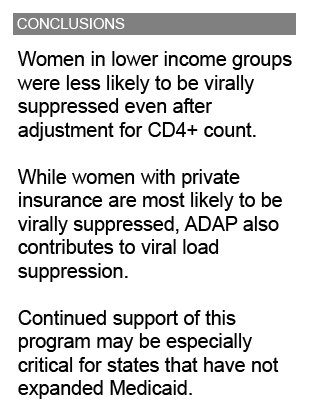

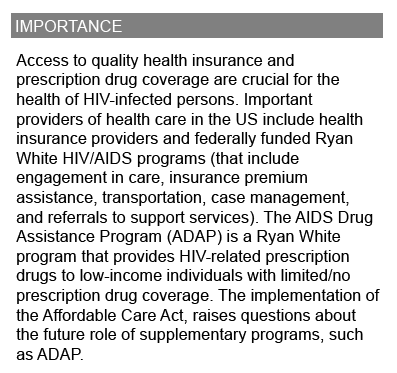
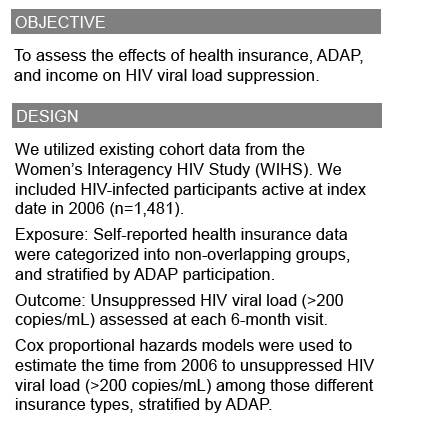
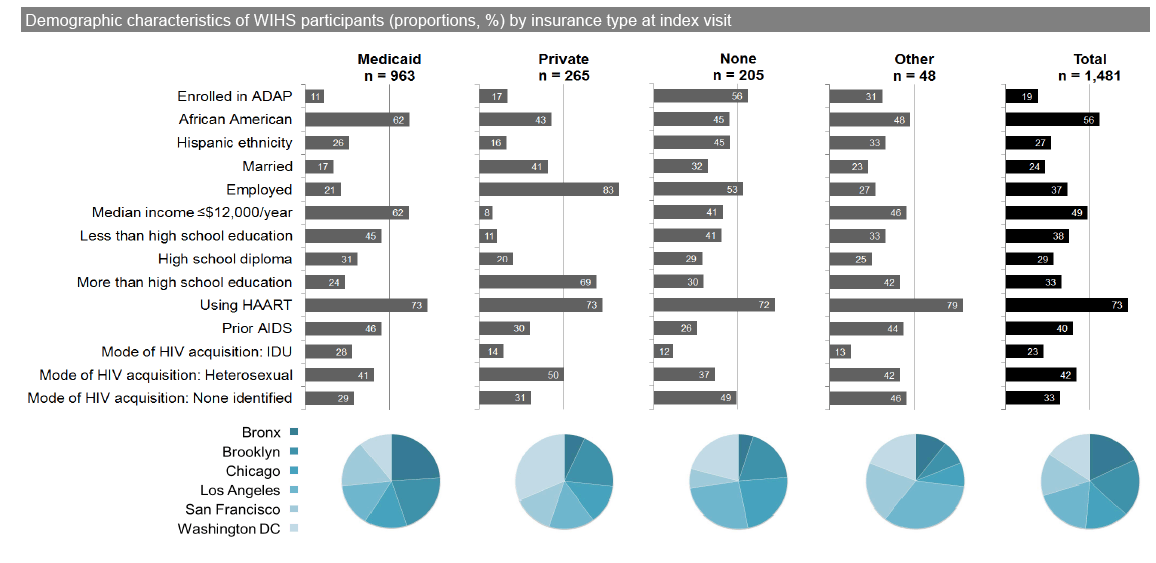
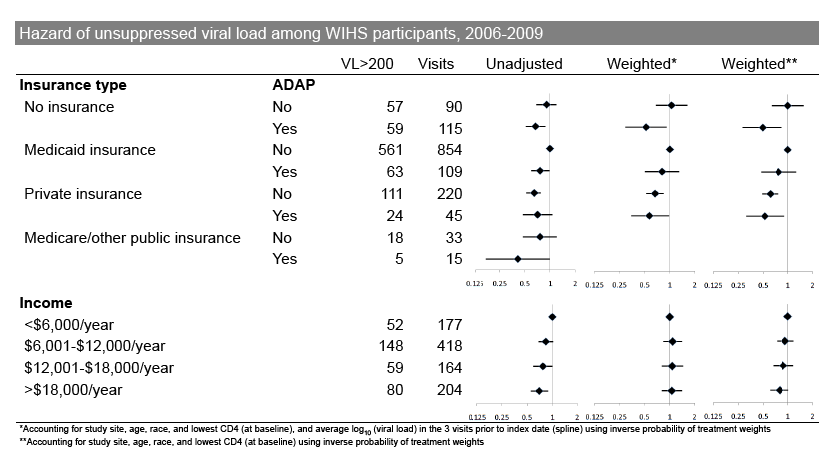
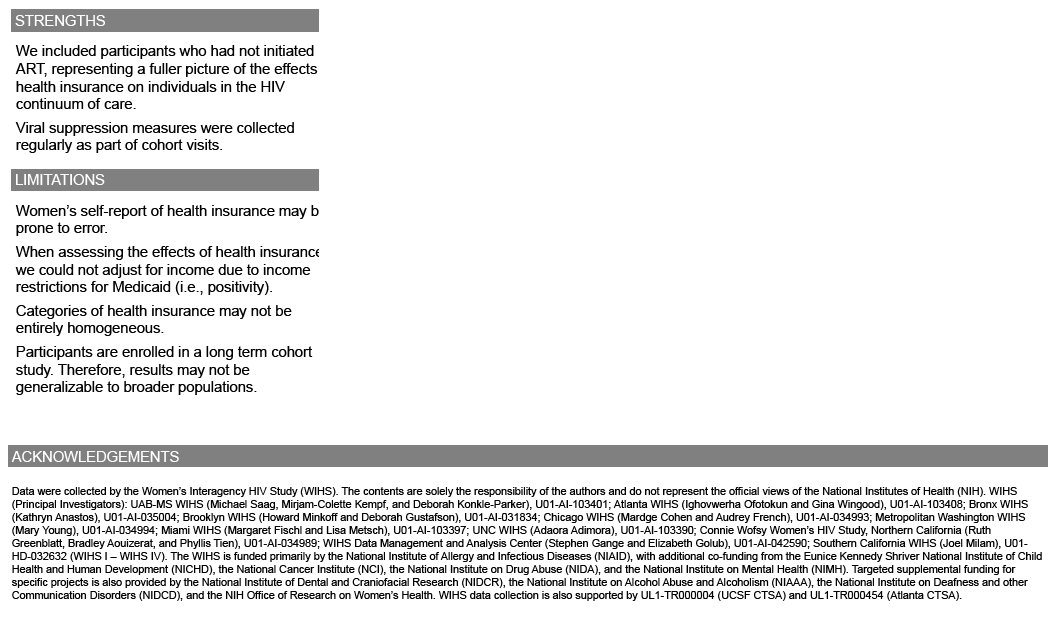
|
| |
|
 |
 |
|
|